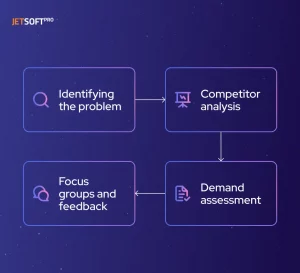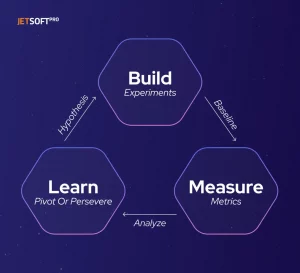Do you have a great idea, but you’re not planning to develop the business and would rather sell it for a higher price? Well, ideas don’t sell well unlike MVPs. A Minimum Viable Product (MVP) is a compromise for those who want to make money from their idea but are not ready to invest too much time and effort into the project. In this guide, we provide detailed instructions on developing an MVP, package it to increase its value, and eventually sell your startup at the MVP stage.
How many people sell their startups at the MVP stage?
From 2015 to 2020, the number of first-time venture capital financing deals worldwide steadily declined. The industry picked up in 2021, but then the tech recession hit, and the already risky venture investments (roughly 90% of venture investments fail) dropped significantly. While there remains interest in investing in tech startups, investors in 2024 are much more selective than before. If you still had hopes of selling just an idea, understand that this market is closed.
Read: 9 Software Startup Ideas For Your Business in 2025
When choosing projects to fund, investors focus on MVPs with proven market potential. From 2017 to 2022, about 4.5 million new startups were launched annually in the U.S. As you can imagine, the selection for investment is vast, and competition is fierce.
How to prepare for selling your startup at the MVP stage
When you have an idea, you need to conduct initial research, plan the MVP, find someone to create it quickly and affordably, test its market potential, and then package your product and prepare your pitch. Let’s walk through each stage step-by-step.
1. Conducting initial market research
Before you sell your startup at the MVP stage, it’s important to research the market to ensure that your idea has potential and that there will be real interested customers. Key steps include:
- Identifying the problem. Many startup founders make mistakes that result in their startups being unnecessary. You need to find a real problem and real people who face it before offering your solution in the form of a product. Don’t mistake the scale of the problem. If you hypothesize that competing products aren’t attractive enough, you’ll likely fail. The problem should be functional and cause specific constraints that people truly suffer from. Moreover, your problem must be solvable. For instance, many people struggle with not knowing how to raise their children to be happy and successful. While this is a real problem, it’s not solvable because complex questions rarely have simple answers.
- Competitor analysis. Identify direct and indirect competitors, study their strengths and weaknesses, and analyze their market position. Market position refers to the part of your potential audience that is currently loyal to your competitor and won’t switch to your product when you launch.
- Demand assessment. Evaluate market demand for your product using surveys, interviews, or trend analysis in your niche. Read online comments, but remember that they rarely reflect the full picture. Use Google Trends to understand audience interest in your idea. This will also help to sell your startup at the MVP stage.
- Focus groups and feedback. Involve target users to pre-evaluate your idea. This will allow you to gather real feedback and adjust the product before development. Target users are not your friends and family! You need a focus group made up of representatives of the audience for whom you’re building the product. If you think your product is for everyone, don’t even start.

2. Planning the MVP
An MVP is the minimal version of your product that contains only the key features necessary to validate its viability in the market. It’s important to plan which features will be included in this version. A common mistake startup founders make is prioritizing beauty and convenience over functionality in the MVP. The MVP should only perform the main function that solves the audience’s problem. If the audience doesn’t use your product because it’s not attractive enough, it likely means you missed the mark in defining the problem.
For example, if your audience suffers from sleep deprivation, a device that helps them sleep can be bulky, ugly, and expensive, and come with a 900-page manual — but people will still buy and use it. In that case, the MVP was successful.
- Defining key features. Focus on the features that solve the primary problem of your target audience. Additional options can be added later if the idea proves viable. This can be difficult, as you likely have a vision for the product, and it may turn out that the idea needs to be changed entirely. The only advice here is to trust the data from your audience, not your imagination.
- Prototyping. Create a prototype (e.g., design using Figma or InVision) to visualize and test the user interface before development. Again, focus on functionality, not aesthetics.
- Optimizing costs and development time. Working with experienced outsourcing teams or freelancers can help you develop an MVP quickly and affordably. JetSoftPo has been developing budget MVPs for tech products for over 20 years. We know how this market works and how to create a minimal product that will have added value. We can help you!
A word of caution
You may come across companies willing to develop an MVP for you for free in exchange for a share of the profits from selling the idea. This is an option, but be careful. Often such offers come from beginner developers whose main goal is to build their portfolio to sell services. Such teams may not have enough experience or motivation for your success; often, they just need a visualized prototype to add to their presentation.
3. Testing market potential before you sell your startup at the MVP stage
Before selling your startup at the MVP stage, ensure that you have a clear marketing plan that proves to investors there will be demand for your product. You need to attract an audience, get people talking about your product on social media, and have videos made about it on TikTok. You need to create an independent information field around your product so that investors can see the obvious interest from the audience.
Marketing steps to take:
- Create a landing page. The simplest way to gauge interest in your product is to launch a landing page describing your idea, with the option for early access registration.
- Content marketing. Start promoting your landing page through blogs, social media, and newsletters to generate interest in your product before its launch. Try to engage influencers — early users who have a large following.
- Testing advertising channels. Use paid channels (Google Ads, Facebook Ads) to test demand. This will quickly give you data on how interesting your product is to the target audience. Allocate part of your budget for this activity because there’s no conventional way to test audience interest faster.
4. Packaging the product for sale
Once the MVP is ready, it’s crucial to package it properly to attract potential buyers:
- Create an investment pitch. Your pitch should cover key aspects of the product: the problem it solves, the target audience, current results, business model, team, and development plan. The most important part is the results. Concrete facts always trump abstraction. Numbers are better than ideas.
- Legal protection. Be sure to register your trademark and protect intellectual property.
- Financial model. Prepare a detailed financial model with revenue and expense projections to show potential investors or buyers the project’s profitability. You should have a plan for how your product will make money from an average user over its lifetime and how you can increase revenue per user by enhancing features. You need to sell what’s sellable to investors, and that requires specific formulas and models, preferably tested.
5. Preparing for the pitch
If you’re not good at being persuasive — confident, reliable, and explaining the value of your idea — you’ll have a tough time.
- Practice your presentation. Make sure you can confidently and clearly present your product. Practice in front of colleagues or mentors to receive constructive feedback. At JetSoftPro, we can also help with this.
- Highlight growth potential. Investors and buyers are looking for not just the current value of the product but also its future growth prospects. Show how you plan to scale the project after the MVP so that by the end of your short presentation, every listener understands — this is a gold mine!
How the Lean Startup method can help you sell your startup at the MVP stage
Lean Startup is a business methodology focused on rapid hypothesis testing and minimizing risks. Developed by Eric Ries, it aims to create products that immediately meet market needs with minimal time and resources. The core principles of Lean Startup include iterative development, rapid experimentation, and constant learning based on user data.
How Lean Startup applies to MVP development
In the context of developing a Minimum Viable Product (MVP), Lean Startup helps focus on the main features of the product, avoiding unnecessary costs. The process works as follows:
- Building the MVP: You develop a basic version of the product that includes only the most important features needed to solve the key problem of your target audience.
- The “Build — Measure — Learn” cycle: After launching the MVP, you collect feedback from early users, measure success metrics, and analyze the data to understand what aspects need improvement.
- Pivoting (changing direction): If the results show that the idea isn’t resonating with the market, the Lean Startup methodology suggests a quick pivot — changing the product, business model, or target audience based on new data.

Lean Startup allows you to create a product that better meets user and market needs, making your startup more attractive to potential investors and buyers. Here’s how this method aids in selling a startup:
- Reducing risk for the buyer: An MVP tested with real users shows that the product has real demand, alleviating investors’ or buyers’ fears of project failure.
- Quick adaptability: The flexibility of the methodology allows you to quickly adapt the product to new market needs, increasing its value to potential buyers who see the potential for further scaling.
- Resource efficiency: Lean Startup helps minimize development costs and test the product with minimal investment, making the startup more financially attractive to the buyer.
- Real market feedback: Having data from early users (and their reviews) adds weight and credibility to your offering.
You can try the Lean Startup approach by launching your project on platforms like Product Hunt or BetaList, or on crowdfunding platforms. This is a quick way to get feedback from tech-oriented users. However, understand that running a campaign on such platforms is a labor-intensive game played by certain rules, and you’ll need to work hard to attract attention and get enough feedback.
If you’re nurturing a new product idea right now, write to us, and we’ll help you develop a minimal product version so you can sell your startup at the MVP stage and make money from the idea as quickly as possible.

